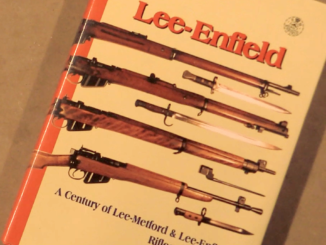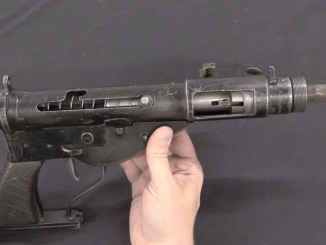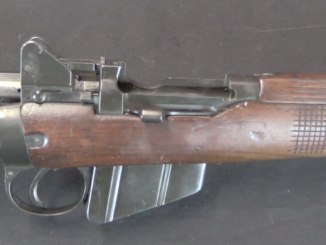Humans have been killing animals for thousands of years, and with the development of the self-contained cartridge, the Greener company started making a compact and efficient Humane Horse Killer. Used by veterinarians for euthanizing creatures (versions were made for pretty much all major domesticated animals), they were made into the 1960s. This type of device is known as a “free-bullet” design because it uses a traditional cartridge, as opposed to the captive-bolt designs which maintain positive control of the lethal end of the device and retract it into the unit after firing.
This particular Greener model is one of the more commonly encountered types, as it was used by the British military (which used horses in great numbers in both World Wars) and was a standard piece of equipment for troops tasked with overseeing care of those horses.




Do you have any info one what this device would have cost when it was made?
They are advertised in the old gun catalogs. Mine are not a accessible at the moment.
There’s something morbidly fascinating/haunting about the dimples on the firing mallet, you don’t often get such an obvious testament of hard use for a weapon. That said it could have accumulated them over years of service, because it doesn’t look like a design that’d break easily.
More than likely that was over years of use. And remember, that mallet/cap is brass, which is a softer metal than the steel firing pin. I’m sure each and every use left its own dimple, given that the user would have given the device a sufficiently spirited whack to make sure of detonating the cartridge.
Hi.. These were on military issue up to the early seventies when Greener disappeared and the ammunition was no longer available.. It used a solid lead heeled bullet almost identical to the .310 Cadet. The Killer for cattle had a similar firing mechanism, but with a brass safety bar that swung over the firing pin and a larger bell shaped stand-off tube made of brass and a separate mallet.
The pocket horse killers were widely used by race course veterinary surgeons (who were nearly all ex military!) to kill horses with broken legs until the 1980s. There was then a general move to “put horses to sleep” using drugs as spectators did not like to hear the sound of a shot..
Free bullet and captive bolt guns are used for different things.. Free bullet killers do actually kill by sending a bullet into the lower brain and upper spinal area. They are used, as Iain says, for killing injured animals in the field and on farms. Captive bolt devices are used for slaughtering as they do not actually kill the beast. The bolt stuns the animal which renders it immediately insensible. It is then killed by having its neck slit.
Just a small point.. the correct loading drill is to fully assemble the killer before loading it..
Not usable for slaughterhouse since you would need to remove the bullet.
More information on the types of these “firearms” and an illustration from the Greener. http://firearmshistory.blogspot.com/2011/03/utility-firearms-meat-processing.html
If someone were of a nefarious turn of mind, the Humane Killer could easily be disguised as a pocket telescope or even the barrel of a microscope. Add a third section housing a sound suppressor and you’d have a useful close-range assassination weapon that might easily be missed by a cursory security search.
Here is what the other versions looked like, and how they were supposed to be used;
http://www.nrvoutdoors.com/HUMANE%20KILLERS/BANG_files/image003.jpg
Similar devices are still made and still used. Here is a page about them and their effects (Warning; PM photos included);
http://what-when-how.com/forensic-sciences/humane-killing-tools/
On a literary note, a blank-cartridge powered, captive-bolt, cattle-sized Greener Humane killer figured prominently in The Unicorn Murders, one of the Sir Henry Merivale mystery novels, written by John Dickson Carr (w/a “Carter Dickson”) in 1935;
https://en.wikipedia.org/wiki/The_Unicorn_Murders
cheers
eon
Yikes, you’re right about that concealed approach. The only downside is that one would need to have the intended victim in a very noisy or isolated place where telescopes or microscopes were plentiful…
That’s why the added suppressor bit. Also note that “back in the day”, travelers often carried telescopes of the “spyglass” type the way they carry binoculars, etc., today.
The pistol-like “Safti-Killer” version was the one used in the Carr novel, IIRC. That would be a bit harder to conceal, or explain, but on the “up” side due to its captive piston “bolt” it was quieter than the bullet-firing version, making about as much noise as an air pistol.
This was deliberate on Greener’s part; since the Safti-Killer was designed for use in a slaughterhouse, the less noise that could spook the animals, the better.
Someone who was feeling very nasty indeed could of course conceal a Safti-Killer like any other handgun, in a false-bottomed suitcase, cut-out book, etc.
I suspect that Carr’s use of it was why it never showed up in any of Ian Fleming’s James Bond novels. He was always looking fro exotic ways of doing people in, but he never wanted to be seen as a copycat.
That said, a weapon that left a whacking great hole in a man’s skull but no bullet, powder residue,etc., would seem to have been ideal for Smersh. Imagine one concealed by being built-in to an umbrella or walking-stick.
cheers
eon
Bulgarian umbrella murder, anyone? Or maybe the walking stick used by Colonel Sebastian Moran in Sherlock Holmes: A Game of Shadows ?
Concealed guns like that used to be more common than you might think. Lewis Winant devoted an entire chapter to them in Firearms Curiosa.
“Cane guns” came in percussion, pinfire, rimfire, centerfire, rifle, pistol, and shotgun persuasions. There were also “air canes”, basically what we would call pre-charged pneumatics (PCP) today.
Interestingly, re our conversation on French gun laws the other day, cane guns were for a long time purchasable without certificate in France, because since they mostly fired “obsolete” cartridges (such as .45 Colt or .44 Special) and had to be manually reloaded for each shot, they were legally defined as single-shot rifles.
BTW, the rifle disguised as a crutch in “The Day of the Jackal”? Under French law, the only thing about it that would have required a certificate was the sound suppressor, or “moderator”. Especially since it was a .22 WMRF.
See “taxidermist’s gun”.
cheers
eon
Last year I spotted a device sold in Europe for veterinarians who might have to euthanize livestock out in the field. It was a 9mm single shot pistol with integral silencer. Probably didn’t have a rifled barrel since it was designed for contact or very close range.
Because of the handgun ban in the UK a number of two shot pistols have been marketed as Humane Killers. The Police are happier to licence these rather than a proper handgun.
… a load of nonsense of course!
Oh, nearly forgot, I saw some video of a horse processing facility where they used air powered carpenter’s framing nail gun to put down the horses. The horse would be restrained in a narrow chute and a worker would press the nail gun to it’s head and fire. The animal dropped immediately and would be dragged away and next horse brought forward.
While I cannot be definitive, I would have to suspect that it might be more likely that what you saw was a compressed-air captive bolt humane killer in action.
It seems slightly odd that it wasn’t just a single shot pistol made for that role. I wonder too how often injured horses would have been too spooked to safely use something like this. The angled face of the muzzle device to aid appropriate placement was a good idea though. Shooting livestock always sucks as a job and when using a rather weak cartridge it’s reasonably easy for things to go wrong.
https://www.all4shooters.com/en/Shooting/pistols/B&T-VP9-9mm-single-shot-repeater-silenced-pistol/
Hank youre thinking about the ‘VP9’ Brügger, a welrod copy(I suspect) .. the brits dropped a good number of those Guys for the resistance here
NFA questions: Why isn’t this an AOW? is it because its in the Curio-Relic category? Also is the lack of baffle(s) the only thing keeping the expansion chamber from being a suppressor, that would need a tax stamp?
I suspect it’s because it requires that brass cap to be used to give the striker a sharp rap to set it off. That makes it a “device” that lacks an actual completely built-in firing mechanism.
As for the expansion chamber, if you added baffles or just a roll of brass screening and a half-teaspoon of water, yes, it would be a sound suppressor. But keep in mind that fired as intended (in contact with an animal’s head), the muzzle blast that escaped the expansion chamber would mainly be absorbed by gas intrusion into the animal’s skull cavity, along with powder residue, etc.
In effect, the animal’s own head would be the “suppressor”. And the gases, expanding inside the skull, would probably cause that much more trauma, adding to the intended effect on the animal, i.e. killing it by instantly pulverizing a good part of its brain.
cheers
eon
FYI, having used one of these many times, there is very little, to no noise suppression afforded by either the expansion chamber or the concept that the gasses enter the animal’s head (which they really don’t). There is still a big “bang”.
Dick Francis’ novel Bolt used one, too.
Funny. I was just reading about this in W.W.Greeners book. The next chapter is about the Maxim silencer.